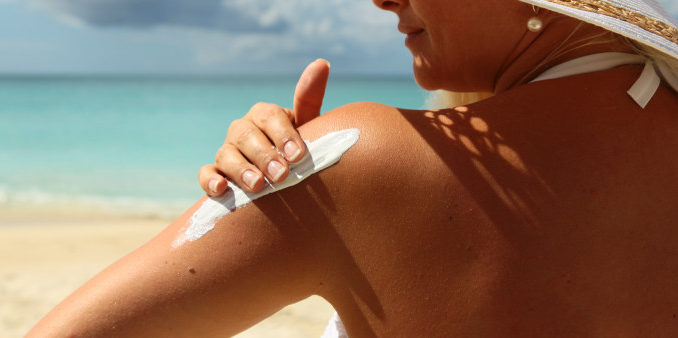
Sometimes it’s not just the task of deciding which tanning lotion to use that you’re worried about before tanning. Or deciding whether you should tan in the sun or go for sunless tanning. Along with these concerns, many women and men also think about how long does a tan last.
Be it natural sun tanning, spray tanning, or using a tanning bed, this question is a valid one. I mean you are going through the trouble of getting a tan, so it might as well last for long. In that case, does it? The answer here depends on many factors. So let’s begin from scratch, shall we?
About Tanning and Tanning Lotions
When UV rays from the sun or tanning beds come in contact with your skin, they produce melanin. Melanin is a pigment that causes the skin to become brown. It’s actually your skin’s natural reaction to provide protection against the damage caused by the UV rays of the sun.
Sun tanning creates a tan because of the interaction of UVA rays with your skin. As for the UVB rays, most of it gets absorbed by the ozone layer. But tanning beds offer both UVB and UVA rays, which have a higher energy than natural UVA rays. This means tanning beds can and do damage DNA. They’re linked to skin cancer as well.
Now let me tell you a little something about spray tans. They contain DHA (dihydroxyacetone), which is a chemical-based coloring agent found in most tanning lotions. And what it does is darken your skin cells temporarily. It helps in getting a tan without actually exposing your skin to the harmful rays of the sun.
But DHA itself is not a safe ingredient. So it’s great news to know that there are many indoor tanning lotions now that contain minimal to zero DHA.
I’m sure you already know that tanning offers no health or skin benefits. It’s only the beautiful sun-kissed glow that draws so many people towards it. As for how long does that tanned look last, the time varies depending on the method of tanning you choose. But you can extend the lifespan of your tan. Even so, tans are never permanent.
How Long Does a Tan Last?
Once again, the answer depends on the method of tanning. It also varies from one skin type to another. Even how your particular skin regenerates determines how long the tan will last.
Generally speaking, you can expect a tan to be with you for around 7-10 days. Following which your skin’s outer layer starts to naturally exfoliate. But spray tans begin to fade in a single day if you don’t follow tanning aftercare instructions. Otherwise, they too can last for 7-10 days.
Some tanning experts also highly recommend women to tan after their menstrual cycle and not during it.
Can You Make A Tan Permanent?
Obviously not. Never expect any tan to stay on permanently. And that’s because your skin has a natural ability to shed and make way for new skin cells. This is what fades your tan in the first place. When new skin cells take form, the old, tanned ones are eliminated.
If you happen to come across or know someone with a “permanent” tan, then maybe they have a naturally darker skin. Or he/she uses sunless tanning formulas or is out in the sun too often.
Ways to Make A Tan Last Longer
-
Prep before tanning
The most effective tip for a long-lasting tan is exfoliation before tanning. What exfoliation does is gets rid of dead skin cells right before the tanning procedure. This means the tanned effect takes form on the new, fresh skin cells that are not likely to slough off anytime soon.
An exfoliating body wash is the best way to prepare your skin for exposure to UV rays. It ensures a more even, deeper tan. When you exfoliate, you’re eliminating all the dead skin cells responsible for making your skin look dull and dry. So your tanned appearance looks even more well-balanced and smoother.
-
Tan safe
Funnily enough, the idea of looking like old parchment sounds appealing to many tanning enthusiasts. No wonder there are so many of them just soaking under the sun for longer than they should. Now you need to understand that this is not a safe way of tanning. You don’t have to cook yourself alive to achieve a beautiful tan.
Your skin just won’t allow it. Plus, it’s counterproductive, meaning burnt skin begins the repair damage sooner. This means your skin’s natural, instinctive response, at this point, is to create new cells quickly. So the damaged ones can shed before they turn cancerous. As a result of which your skin starts to peel, thus fading your tan sooner than expected.
But you can avoid all this tragedy simply by incorporating sunscreen into your tanning sessions. Just make sure it’s a broad-spectrum lotion to protect you from both the harmful UVB and UVA rays. And go for SPF 30 or higher. Don’t choose sunscreen below SPF 15 as it’s no good.
-
Cool off after tanning
After leaving on the tanning lotion for the recommended amount of time, it’s time to cool off. And by cool off, I mean increase the temperature of your bath water. Showering with cool or cold water is going to make your skin feel warm again.
Just avoid hot water as it is very likely to damage the natural barrier of your skin. Scalding water also destroys your skin’s natural oils that help with moisture and tan retention. When you use hot water, whether tanned or not, it causes skin dryness. But this is even worse in the case of tanned skin because dryness welcomes skin peeling, which means tan fade.
So keep your showers cool after tanning. And incorporate bath products equipped with hydration. Go for ingredients like jojoba oil, shea butter, and aloe vera.
-
Apply a tanning accelerator
For optimizing results, nothing works better than using a tanning accelerator. It not only speeds up the process of tanning but such formulas are also used for maintaining your tan. But how is that possible? Tanning accelerators artificially stimulate the production of melanin.
However, they’re not good to use if your skin is likely to develop hyperpigmentation and dark spots. Too much melanin in the skin due to the sun does that you know.
-
Moisturize daily
If you want to prevent your tan from fading quickly, then make it a point to moisturize daily. Skin requires hydration in the form of a good, natural moisturizer. Irrespective of whether it’s tanned or not!
So no matter if your skin is dry, oily, or sensitive, use a moisturizer on a daily basis. Just make sure it’s a lotion specifically crafted for your skin type.
You can also start drinking more water to provide your body and skin with more natural hydration.
The End
When using tanning beds, your bronzed look can last from anywhere between 7 and 10 days. Tanning enthusiasts usually go for one session every few weeks to maintain that sun-kissed glow. But this is not set in stone. Meaning your tan can last for a shorter or longer time. It all depends on your skin type and how quickly or slowly your skin cells regenerate.
But on a general note, 7-10 days is the norm. However, I have discussed effective tips to achieve a longer-lasting, more even tan. It’s not that difficult to follow these tips if you’re a regular tanner or are crazy about tanning.


Be the first to comment